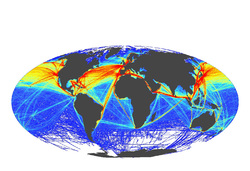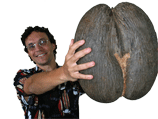Recipe for a new species ('speciation'): take some individuals of an existing species, move them to an isolated area, leave them to breed for many generations, allow them to adapt to the new environment… Result – new species. There are a few variations on this theme but this in essence is how speciation works. Example: Over many, many, many years a pigeon evolved into a dodo.
Recipe for species movement without evolving into a new species (range expansion): take some individuals of an existing species, move them to a new area that is not isolated, continue to move individuals of an existing species into the new area... Result – same species but with an expanded range. Example: Human beings who have spread throughout the world but we are still just one species.
Recipe for biological equilibrium ('dynamic equilibrium'): take some individuals of an existing species, move them to a new area, the new species increase in numbers and overuse resources, there is some premature death - perhaps from predation or disease or lack of food and/or migration, and new fluctuating (“dynamic”) equilibrium levels are reached. Example: The cyclical movement of wildebeest in the Serengeti and Masai Mara in Tanzania and Kenya.
So if species movement, which has been going on for as long as life itself, leads to new species, range expansion and dynamic equilibrium then what’s the difference between ‘natural’ species movement and human-induced biological invasions. Simply stated, there has been a dramatic change in the numbers of species moving and type of species movement compared to the situation in pre-human times.
Pimentel (2001) estimated that more than 400,000 species have been moved from one region of the Earth to another by human agency over the past 10 000 years – that’s a serious shuffling of the pack! So why does this frequency matter? In a nutshell, ecosystems just don’t have enough time to adapt. Imagine a species introduction as a pebble thrown into a pond. If you throw a single pebble into a pond it will cause ripples but the movement will settle down soon enough. If you continue to throw pebbles…, and rocks…, and boulders into the pond the water will be in a constant state of disturbance. It will never return to an equilibrium because it is never given the time to recover.
Some of these species (the ‘pebbles’ if you will) may have been able to colonise a recipient ecosystem without our help - I call this group the ‘couldhavegottheres’. But there is another group of species (the ‘boulders and rocks’) that would almost never have been introduced to certain places without our help. I call this group the ‘neverwouldhavegottheres’. Human action has enabled this group to overcome barriers that previously prevented them from getting to certain places. More often than not its the neverwouldhavegottheres that are the most troublesome to the recipient ecosystem.
Couldhavegottheres include seeds and spores, insects and other invertebrates, birds and mammals, and reptiles that originate in places close to the recipient ecosystems. Neverwouldhavegottheres include rats, cats, mongooses and other ground-dwelling mammals that are brought to isolated oceanic islands; freshwater fish from Asia that are introduced to the Americas and vice versa; clams, mussels and crabs that are moved between the Atlantic and the Pacific Oceans in ballast water; and species that have been separated for millions of years who can now colonise previously inaccessible seas through the Suez and Panama Canals.
Recipient ecosystems can take a real hammering when a new kind of species makes its entrance because species adapt to what is and was present and not to what has never been present.
So are biological invasions just a slightly accelerated version of business as usual?
In a single word… NO!
In a few words… NOT EVEN CLOSE!!
Some suggestions for addressing Red Herring #3
Fortunately this red herring is one of the easier ones to address - we need to clearly outline the differences between background (pre-human) and current species movement, both in terms of quantity (frequency) and quality (overcoming nature’s barriers) and the reasons why these changes can result in severe impacts if effective management measures are not taken. These ideas are simple to explain and once outlined often contribute to Ah-Ha moments. So that’s why rats are such a big deal on isolated islands! or Now I understand why you need to manage the movement of ballast water! are common rejoinders.
All of this is biological invasions 101 for the cognoscenti but we, the so-called experts, forget that we take a great deal of our knowledge for granted. At all times we need to guard against the curse of knowledge when communicating with people from different backgrounds to ourselves.
Coming up next: Red Herring #4: Concern about species introductions is essentially racism - Species introductions, like human immigration is a positive thing and those who advocate managing the process are eco-fascists.
Reference
Pimentel, D. (2001). Agricultural invasions. In Encyclopedia of Biodiversity, vol. 1 (ed. S. A. Levin), pp. 71–83. San Diego, CA: Academic.



 RSS Feed
RSS Feed
